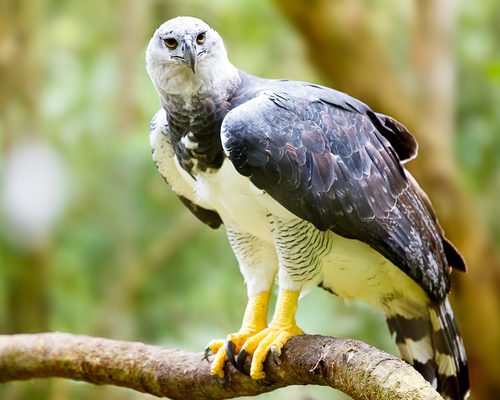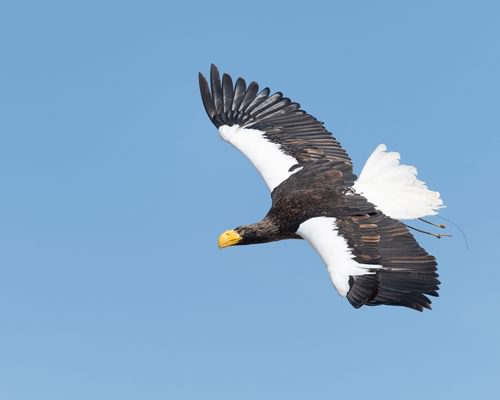Philippine Eagle
Critically EndangeredPithecophaga jefferyi
Visual Identification
Appearance
The Philippine Eagle is a massive raptor with a dark face, pale brown nape, and creamy-white underparts.
Its most striking feature is a shaggy crest of long, brown feathers that gives it a distinctive silhouette. The powerful hooked beak and large yellow talons are adapted for hunting.
Adults have similar plumage, with no significant differences between sexes. Juveniles are paler overall, with a white-edged brown crest and less defined facial markings. The bird's plumage remains consistent year-round.
Size
Length
86cm to 102cm
Wingspan
184cm to 220cm
Weight
4.04kg to 8kg
Colours
Males and females have similar plumage
Primary Colour
Brown White
Secondary Colour
Grey
Beak Colour
Grey
Leg Colour
Yellow
Habitat and Distribution
Habitats
Woodland
Garden
Wetland
Coastal
Urban
Farmland
Grassland
Desert
Tundra
Rainforest
Mountain
Savanna
Distribution
Philippine Eagles are endemic to the Philippines, inhabiting the islands of Luzon, Samar, Leyte, and Mindanao. They require large tracts of primary tropical rainforest, preferring undisturbed areas with tall trees for nesting and hunting.
These eagles are non-migratory, maintaining year-round territories. Their range has significantly decreased due to deforestation, with the largest remaining populations found in the eastern Mindanao mountains.
Elevation Range
150 to 1,800 meters
Climate zones
Tropical
Distribution Map
This map gives you a rough idea of where you might spot a Philippine Eagle. The coloured areas show countries where these birds have been seen.
A few things to keep in mind:
- Birds might not be everywhere in the coloured areas, for example, they may be present around the coast of that country
- Where birds live can change with seasons and available food
- This map is quite simple - it doesn't show exact locations
We're working on making our maps even better! Soon, we hope to show you:
- More detailed maps for bigger countries, including state and region
- How birds move around during different seasons
Distribution by Region
Behaviour and Ecology
Bird Attributes
This feature is in beta. We'd love your feedback to improve it!
Share your thoughtsBird Attributes Explained
Our bird attributes system rates various aspects of a bird's capabilities on a scale of 0-100, based on data from field observations, scientific studies, and expert knowledge.
Attribute Categories:
- Agility: Manoeuvrability, speed, and grace in flight or movement.
- Strength: Physical power, often correlating with size and hunting abilities.
- Adaptability: Ability to thrive in various environments or changing conditions.
- Aggressiveness: Territorial behaviour and assertiveness, particularly during breeding seasons.
- Endurance: Stamina, often seen in migration patterns or foraging behaviours.
Understanding the Ratings:
- 0-20: Very Low
- 21-40: Low
- 41-60: Average
- 61-80: High
- 81-100: Very High
Remember, these attributes are relative to other bird species and don't necessarily indicate superiority.
Hover over the icon next to each attribute for more information.
Tap the icon next to each attribute for more information.
Agility
Reflects the bird's manoeuvrability, speed, and grace in flight or movement.
The Philippine Eagle possesses exceptional agility, with the largest wingspan-to-body-length ratio of any eagle. This allows for remarkable manoeuvrability in dense forests, crucial for hunting in its habitat.
Strength
Indicates the bird's physical power, often correlating with size and hunting abilities.
As one of the world's largest and most powerful eagles, it demonstrates immense strength. Capable of carrying large prey like monkeys and flying lemurs, its robust build and powerful talons make it a formidable predator.
Adaptability
Represents the bird's ability to thrive in various environments or changing conditions.
While highly specialised for its rainforest habitat, the Philippine Eagle shows adaptability in its diverse diet and ability to hunt both in trees and on the ground. However, its specific habitat requirements limit its overall adaptability.
Aggressiveness
Measures the bird's territorial behaviour and assertiveness, particularly during breeding seasons.
Though not typically aggressive towards humans, the Philippine Eagle is a fierce predator. Its silent, stealthy hunting technique and ability to take large prey indicate a high level of predatory aggression.
Endurance
Reflects the bird's stamina, often seen in migration patterns or foraging behaviours.
The Philippine Eagle's ability to soar for long periods, maintain large territories, and provide extended parental care (up to 17 months) suggests impressive endurance. Its potential lifespan of up to 60 years in captivity also indicates robust stamina.
Diet
Philippine Eagles primarily hunt mammals, including flying lemurs, monkeys, and palm civets. They also prey on other birds, snakes, and lizards.
These versatile hunters use their powerful talons to snatch prey from trees or the ground, often carrying large animals back to their nests.
Behaviour
Philippine Eagles are solitary and territorial, with pairs maintaining large home ranges. They soar gracefully on thermals, using their keen eyesight to spot prey.
These birds are known for their silent, stealthy hunting technique, often perching motionless for hours before swooping down on unsuspecting prey.
Vocalisation
Philippine Eagles have a range of vocalisations, including high-pitched whistles and a distinctive whinnying call that sounds like 'wee-ahh, wee-ahh.'
During the breeding season, pairs engage in duets, with males producing rapid, staccato notes and females responding with longer, drawn-out calls.
Nesting & Breeding
Philippine Eagles form monogamous pairs that mate for life. The breeding season typically begins in September and can last until February. Courtship involves aerial displays and vocalisations to strengthen pair bonds.
Nests are massive structures built high in emergent trees, often over 30 meters above the ground. The female lays a single white egg, which both parents incubate for about 60 days.
After hatching, the chick remains in the nest for 4-5 months before fledging. Parents continue to care for the young eagle for up to 17 months, one of the longest dependency periods among birds.
Lifespan
The Philippine Eagle typically lives for 30 to 60 years, with a maximum recorded lifespan of 46 years.
Like all birds, lifespan can be affected by factors including predation, habitat quality, disease, and access to food sources.
Conservation and Status
Global Conservation Status
The Philippine Eagle faces critical endangerment due to habitat loss from deforestation and hunting.
Conservation efforts focus on habitat protection, captive breeding programs, and community education to reduce human-wildlife conflict. Strict laws now protect this species, but enforcement remains challenging in remote areas.
Birdwatching Tips
- Look for them in primary lowland and montane forests
- Scan the canopy and emergent trees for perched individuals
- Listen for their high-pitched whistles and whinnying calls
- Be patient and quiet, as these eagles are easily disturbed by human presence
- Use high-powered binoculars or a spotting scope for better viewing
Additional Information
Quick Facts
Other names:
Monkey-eating Eagle, Great Philippine Eagle
Family:
AccipitridaePredators
Adult Philippine Eagles have no natural predators, but their eggs and chicks are vulnerable to other large birds of prey and arboreal mammals.
Did You Know?
- The Philippine Eagle has the largest wingspan-to-body-length ratio of any eagle, allowing for exceptional manoeuvrability in dense forests.
- It takes about seven years for a Philippine Eagle to reach sexual maturity.
- A pair of Philippine Eagles requires up to 13,000 hectares of forest to sustain a breeding territory.
Was this bird profile helpful?
Your feedback helps us improve our content
Thanks for your feedback!
Your input helps us improve our content.
Community Experience
Community Ratings
No ratings yet - be the first to rate this bird!
Latest Community Reviews
No reviews yet
Sign in to be the first to review
Community Reviews
Create Your Free Account Welcome Back!
Join our community to rate birds and share your experiences. Creating an account is completely free and only takes a minute. Sign in to your account to rate birds and share your experiences with our community.
Your information is secure and will never be shared.
By creating an account, you agree to our Privacy Policy.
Similar Birds
References
- 1
website, 2016: Ibanez, Jayson. "The King is dead, Long live the King!". SunStar Davao.
View source - 2 3 4
website: BirdLife International. 2018. Pithecophaga jefferyi (amended version of 2017 assessment). The IUCN Red List of Threatened Species 2018: e.T22696012A129595746.
View source

